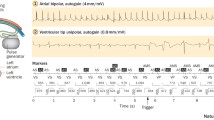Summary
A treatment of patients with paroxysmal atrial fibrillation is the implantation of DDDRP pacemakers for preventive pacing. Atrial pacing with the aim for preventive pacing of atrial fibrillation can be classified as continuous constant pacing with a fixed manually programmed lower atrial pacing rate. The second approach is continuous dynamic overdrive pacing realized by new pacing algorithms, e.g., Pace Conditioning in the Vitatron DDDRP pacemakers. The third approach is discontinuous triggered pacing when specific pacing algorithms are activated by trigger events and temporally pace the atrium. The actual established indications for preventive pacing are patients with a conventional pacing indication and a history of paroxysmal atrial fibrillation. A possible indication are patients with a standard indication for cardiac pacing and a high risk to develop atrial fibrillation as well as patients with drug-refractory atrial fibrillation before AV-node ablation. After pacemaker implantation the pacemaker can be programmed individually according to the onsets of atrial fibrillation observed in the patient or the patient receives a standard programming and subsequently an individual adjustment of the pacing functions. The success of preventive pacing should be assessed a each follow-up visit by interrogation of the extended diagnostic pacemaker counters. There are at present no prospective studies concerning the effects of different pacemaker programming.
Zusammenfassung
Eine Möglichkeit zur Behandlung von Patienten mit paroxysmalem Vorhofflimmern ist die Implantation eines Zweikammerschrittmachers zur präventiven Stimulation. Die Vorhofstimulation zur Prävention von paroxysmalem Vorhofflimmern lässt sich klassifizieren in kontinuierlich konstante Stimulation mit Programmierung auf eine feste Vorhoffrequenz, in kontinuierliche dynamische Überstimulation über den intrinsischen Rhythmus mit dem Einsatz neuerer Stimulationsalgorithmen wie z.B. Pace Conditioning der Firma Vitatron und in spezielle getriggerte Stimulationsalgorithmen, die eine diskontinuierliche Stimulation bewirken, indem Triggerereignisse eine kurzfristige Vorhofstimulation auslösen. Grundsätzlich geeignet sind Patienten mit konventionellen Schrittmacherindikationen und bekanntem paroxysmalem Vorhofflimmern, möglicherweise solche mit einer Schrittmacherindikation und einem hohen Risiko für neu auftretendes Vorhofflimmern sowie Patienten mit medikamentös-refraktärem Vorhofflimmern vor geplanter AV-Knotenablation. Nach Schrittmacherimplantation gibt es zwei Strategien bei der Schrittmacherprogrammierung, eine individuelle Programmierung und eine initiale Standardeinstellung mit individueller Anpassung bei den folgenden Nachsorgen. Der Therapieerfolg präventiver Stimulation sollte bei jeder Nachsorge anhand der erweiterten diagnostischen Schrittmacherspeicher geprüft und ggf. optimiert werden. Aktuell liegen zu diesen Aspekten keine größeren kontrollierten Studien vor.
Similar content being viewed by others
Author information
Authors and Affiliations
Additional information
Eingegangen: 20. Dezember 2001 Akzeptiert: 14. Januar 2002
Rights and permissions
About this article
Cite this article
Schuchert, A., Meinertz, T. Präventive Stimulation bei paroxysmalem Vorhofflimmern: . Herzschr Elektrophys 13, 20–29 (2002). https://doi.org/10.1007/s003990200004
Published:
Issue Date:
DOI: https://doi.org/10.1007/s003990200004




